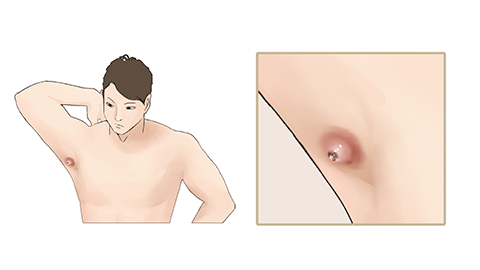What does it mean if there is a lump under the armpit?
Lumps under the armpit may be caused by muscle fatigue after exercise, accessory breast tissue, folliculitis, sebaceous cysts, or filiform warts. Corresponding treatments can be adopted based on the specific cause. If physical discomfort occurs, it is recommended to seek medical attention at a hospital promptly and follow medical advice for management.

1. Muscle fatigue after exercise: After intense physical activity, the muscles and lymphatic tissues under the armpit may become slightly swollen due to fatigue, creating a temporary sensation of a lump. Muscle soreness and mild redness or swelling may also occur after exercise. It is recommended to rest appropriately, perform mild stretching exercises, and apply heat compresses to aid muscle recovery and promote lymphatic circulation.
2. Accessory breast tissue: Some individuals have incompletely regressed breast tissue under the armpit, known as accessory breast tissue. During hormonal changes such as the menstrual cycle or pregnancy, this accessory breast may enlarge and form a palpable lump, sometimes accompanied by distension or pain. Wearing appropriate, comfortable undergarments with good support can help alleviate discomfort caused by accessory breast tissue.
3. Folliculitis: The armpit area contains numerous hair follicles. If excessive sweating and inadequate hygiene occur, the follicles may become infected with bacteria, leading to folliculitis. This condition manifests as localized red papules or lumps, often accompanied by pain. Patients can use topical medications such as mupirocin ointment, fusidic acid ointment, or oral amoxicillin capsules under medical guidance to alleviate symptoms.
4. Sebaceous cyst: Blockage of sebaceous gland ducts in the armpit area may lead to accumulation of sebum and the formation of a cyst. These cysts typically present as smooth, round lumps and are usually asymptomatic unless secondary infection occurs, which may cause redness, swelling, and pain. Patients are advised to use medications such as ichthammol ointment, cefaclor capsules, or roxithromycin capsules under medical supervision to relieve discomfort.
5. Filiform warts: This condition is usually caused by infection with the human papillomavirus (HPV). It manifests as slender, soft, filamentous projections in the armpit area, typically skin-colored or brown-gray in hue. These growths generally do not cause pain or itching. Patients may use topical medications such as tretinoin cream, salicylic acid ointment, or acyclovir cream under medical guidance to improve symptoms.
References:
[1] Yin Meidan, He Aiping, Zhu Junying. Clinical value of fluorescent staining in the diagnosis of Malassezia folliculitis [J]. Heilongjiang Medicine Journal, 2023, 36(04): 936-938.
[2] Dai Shumin, Liu Wenming, Liu Yushu. Clinical application of modified incision and drainage in the treatment of infectious sebaceous cysts [J]. Modern Medicine and Health Journal, 2023, 39(13): 2199-2202.






